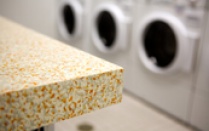
Story by CHARLOTTE HSU
William R. Greiner Hall, UB’s newest residence hall (housing mostly sophomores), provides a glimpse at the future direction more and more buildings at UB will be modeled upon. The building, which debuted on the North Campus in August 2011, is the first of several state-of-the-art structures that have opened or will open on campus over a two-year period. UB’s recent burst of new on-campus construction has already been nationally noticed.
The students living in Greiner Hall take pride in its environmentally conscious features, which earned it a gold rating under the U.S. Green Building Council’s LEED certification system. The building’s architects packed it with innovative surprises, like an irrigation system that draws water from an on-campus lake and laundry room counters made from recycled Tide detergent bottles.
Greiner Hall also encourages a healthy lifestyle for all residents by adhering to universal design — design that empowers people of diverse abilities by encouraging health and wellness and social participation. UB’s Center for Inclusive Design and Environmental Access contributed ideas, and is a leader in this field.
And of course, to make sure its residents have every advantage to succeed in their academic pursuits, Greiner Hall offers dedicated classroom settings, as well as creative spaces for both individuals and groups to relax and unwind with a favorite book, or to enjoy their shared learning and living environment through casual discussions on anything from Pinterest to Pride and Prejudice.
Explore Greiner Hall

The Man Behind The Name
Greiner Hall is named for the late William R. Greiner, UB’s 13th president and a longtime Law School faculty member.
The designation is fitting: During his 42 years at UB—including 13 as president—Greiner’s focus was always on making the UB experience better for students.
He oversaw the construction of five student apartment complexes, led the drive for UB’s athletics program to join the NCAA’s Division 1, and recruited world-class faculty to teach and conduct research with students.




















